The BlackBerry PlayBook Review
by Anand Lal Shimpi on April 13, 2011 9:00 PM EST- Posted in
- Tablets
- Smartphones
- RIM
- BlackBerry
- PlayBook
- Mobile
The PlayBook Browser
Two years ago RIM acquired Torch Mobile, a development house that happened to be a significant contributor to the WebKit project. WebKit also happens to be the foundation for both Google Chrome and Safari (both Mac and iOS versions). Torch Mobile had its own WebKit based browser called Iris, which eventually got folded into BlackBerry OS 6.0 and launched with the BlackBerry Torch.
The PlayBook expands upon Torch Mobile's work with one of the strongest parts of the BlackBerry tablet experience. The PlayBook's browser technically supports tabs however the tab bar isn't always visible as it is with Honeycomb. The PlayBook handles browsing multiple web pages better than the iPad, but not nearly as well as the Xoom.
Scrolling is incredibly smooth, even on Flash enabled web pages. Scroll down too quickly and you'll get an empty screen that takes a moment to catch up with your scrolling. It's not uncommon to see this on iOS, it happens less with the iPad 2 and it seems to happen more with the PlayBook.
Web page compatibility is ridiculously good with the PlayBook's browser, partially due to RIM's excellent implementation of hardware accelerated Flash 10.2. Corner cases that wouldn't work on Android or iOS work perfectly on the PlayBook. While I personally prefer the UI of Honeycomb's browser and the size/screen of the iPad 2, the PlayBook probably offers the best browsing experience from a pure software standpoint of any of the tablets.
RIM's tablet browser passes the Acid3 test and scores higher on the HTML5test than both the iPad 2 and Honeycomb. The PlayBook user agent comes up as: Mozilla 5.0 (PlayBook; U; RIM Tablet OS 1.0.0; en-US) AppleWebKit/534.8 (KHTML, like Gecko) Version/0.0.1 Safari/534.8+.
Nearly all websites treat the PlayBook as a desktop browser and don't force you to a mobile version of the site. This is true for video sites as well, like Hulu and YouTube.
Having full Flash functionality built in to the browser is nice. You can disable Flash entirely if you want to, but leaving it enabled doesn't really impact performance all that much - even scrolling with Flash ads in place remains pretty smooth.
Sites that depend entirely on Flash work on the PlayBook, although controlling pure Flash sites can be a problem. Case in point: Pandora. The web version of Pandora is fully functional on the PlayBook, albeit slow to load. The trouble comes in when you try to use Pandora's integrated scroll bar or actually switch stations. Pandora is optimized for a mouse driven experience, not a touch UI, resulting in a lot of frustrating tapping and really slow scrolling. It's workable, but definitely not desirable.

This is full screen Flash on the PlayBook
Flash video players also work on the the PlayBook within its browser. I was reading an article on abcnews.com the other day with an embedded video. I just tapped the video and it started playing immediately. The same for embedded Hulu videos in Facebook. The YouTube website also works, although RIM ships the PlayBook with a dedicated YouTube client for better browsing.
The problem with embedded Flash video is the same as the Pandora issue: control. You can't really hover to expose controls with a touchscreen so what you end up doing is a lot of quick tapping to try and bring up controls, change the setting you want and get back to playing the video. It's frustrating and doesn't work all of the time. None of this is RIM's fault, but now that tablets are at the point where they can start to behave like notebook/desktops web developers will have to rethink the way they build websites. The web is still the unifying platform between all OSes, it's just a few steps behind in becoming touch optimized.


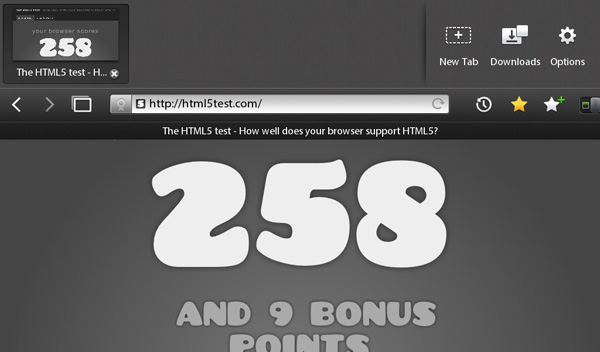
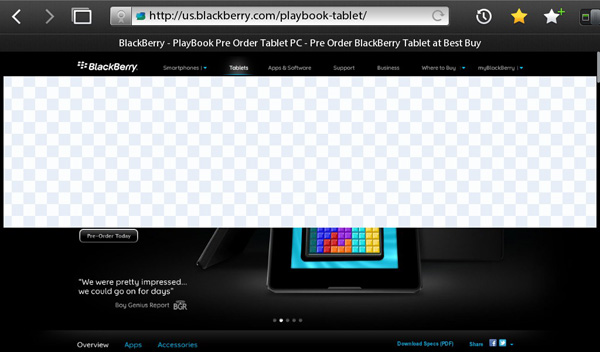
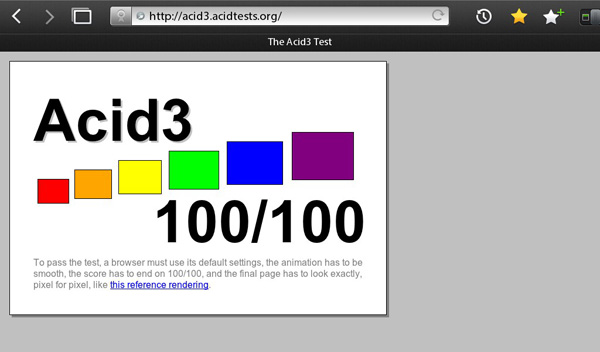
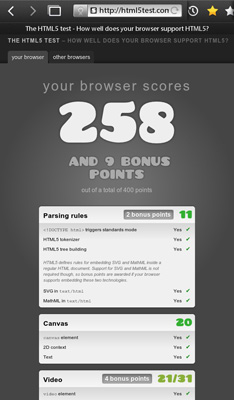
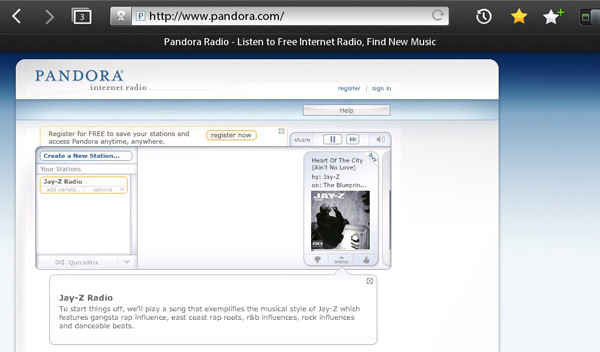








77 Comments
View All Comments
legoman666 - Wednesday, April 13, 2011 - link
No email client? Really? Is that a joke?Ethaniel - Wednesday, April 13, 2011 - link
For now it seems, but that's clearly a sample unit. All I keep reading is "needs tuning" and "needs optimization", ergo, it's not ready, and they're going to launch it anyway. Those updates will have to be lightning-fast. I don't want to pay 500 dollars to be a beta tester...SimKill - Wednesday, April 13, 2011 - link
I'm actually surprised. This is because my cousin in India said that his friend in Dubai already bought it and has it for quite some time. Do you think there might be a reason why they are purposely delaying the American release?melgross - Thursday, April 14, 2011 - link
Probably, someone is lying about it, or they've gotten some illegally obtainedRe
Reduction model much as what happened the Apple's iPhone 4.
It's first being released in N. america, according to RIM.
vol7ron - Friday, April 15, 2011 - link
Why does everyone want to price around Apple? The more I look at these devices, the more I'm likely to get the color-nook and put Droid on it. Surely the hardware would be lacking, but the functionality would still be ballpark.16GB for $500 is ridiculous. These base models need to be in the $250-300 range.
michael2k - Friday, April 15, 2011 - link
Um, the raw materials for the iPad is about $260, meaning you can't expect to buy a 16gb tablet from any manufacturer, especially one with less buying power than Apple, for much less than $400 or so.From the iPad 2:
Display is $127
Flash is about $66 for 32gb, $35 for 16gb
Case & Battery is about $60
Mobo+Camera is about $60
So for any 10" tablet the cost if they gave it away for free would be $282 or so. Your nook "cheaps out" by having a 7" screen, only 8gb storage, a slower CPU, no cameras, and a much smaller battery. It only gets 8 hours with wifi off, the iPad 2 gets 11 hours with wifi on!
In other words you're only paying $180 worth of HW in the Nook, while the iPad gets you two 1GHz cores vs a 800MHz core, 11h of battery vs less than 8 hours, 10" and 1024x768 vs 7"@1024x600, 16gb vs 8gb, and of course, no guarantee of OS updates. You're complaint is ridiculous, actually, since almost no other manufacturer has been able to beat Apple on price yet except the Acer Iconia.
quiksilvr - Friday, April 15, 2011 - link
As much as I despise Apple, I have to agree to an extent. Yes that price is quite hefty, but if Apple didn't have it's cult following, it would have easily been on sale for $399. But thanks to idiot consumers, they can bump it up a Benjamin.michael2k - Friday, April 15, 2011 - link
And no one else can order in vast enough quantities to hit the $399 price.mcnabney - Friday, April 15, 2011 - link
I am starting to doubt the iSupply numbers you quoted.They price the very nice 9.7" IPS screen that Apple uses at $129 while the clearly inferior non-IPS screen the XOOM uses at $140. Their memory prices are also highly suspect, clinging to $2/GB for what are still really small drives compared where higher performing SSDs already are. I would guess that NAND prices for tablets are under $1/GB wholesale and in quantity.
michael2k - Friday, April 15, 2011 - link
Apple orders literally 2m 9.7" IPS screens a month, probably 40m this year alone. That gives them bulk purchasing power no one else has except the manufacturer of said screens.Motorola has to pay market prices, while Apple can literally buy an entire factory's output. http://www.isuppli.com/Display-Materials-and-Syste...
It doesn't help that the Japanese earthquake halted LCD production at major plants, either!
As for SSD chips, Apple is paying a premium to get density. The low end iPad has only a single SSD 16GB chip. The mid range iPad has one or two, and the high end has two 32GB chips. As soon as prices are good or capacity is good, I'm sure Apple will use a single 32gb chip on the low end, two 32gb chips for the middle, and 2 64gb chips on the high end.